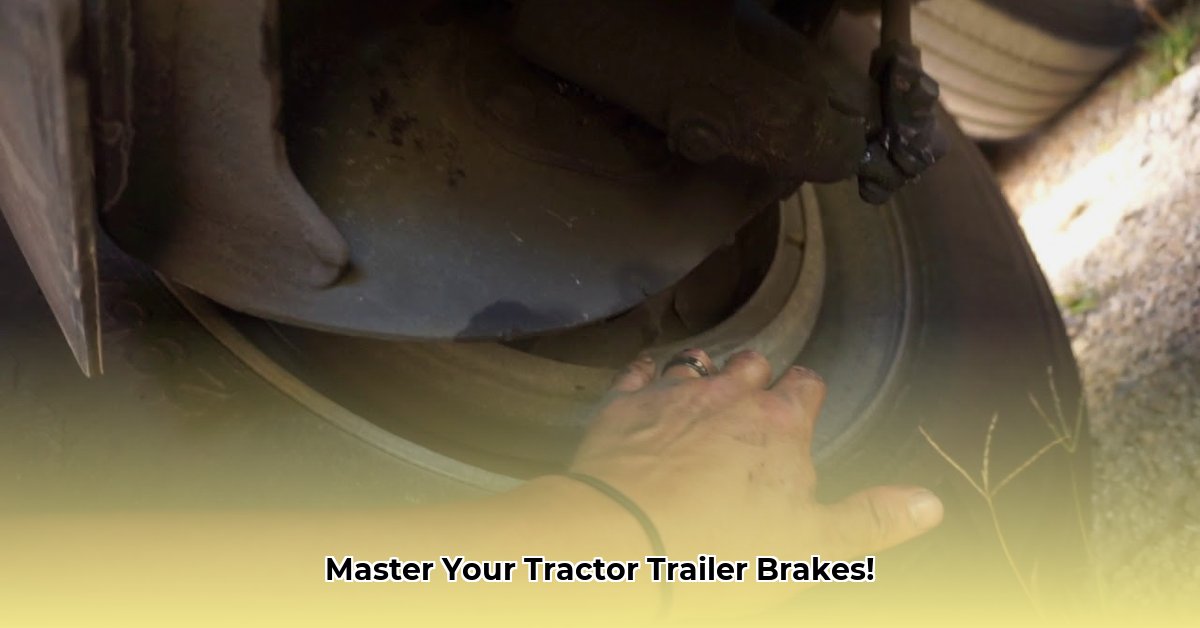
Keeping your tractor-trailer brakes in optimal condition is paramount for road safety. This comprehensive guide provides step-by-step instructions for adjusting both manual and automatic slack adjusters, crucial for preventing accidents and ensuring efficient braking. Regular checks are vital for preventing major issues and maintaining safe operation. For tire maintenance, see our guide on changing a tractor tire.
Understanding Your Brake System
Before starting any adjustment, identify your trailer's brake system. Most modern trailers utilize automatic slack adjusters, requiring minimal manual intervention. Older models, however, often feature manual slack adjusters that require periodic adjustment. Incorrect adjustment can lead to brake failure; therefore, proper identification of your system is crucial.
Drum vs. Disc Brakes
Trailers employ either drum or disc brakes. Drum brakes have internal components within a cylindrical housing, while disc brakes have brake pads clamping onto a rotating disc. While the adjustment process differs slightly based on the brake type, the core principles remain the same. Consult your owner's manual for specific information regarding your trailer.
Manual vs. Automatic Slack Adjusters
Manual slack adjusters require periodic adjustment using a wrench. Automatic slack adjusters, prevalent in newer trailers, self-adjust during normal operation, but may still require professional attention if malfunctions occur. Understanding the difference determines the type of adjustment needed.
Pre-Adjustment Inspection: A Critical First Step
Prior to any adjustments, conduct a thorough pre-inspection. This preventative step helps identify potential issues before they escalate into more serious problems, saving time and money in the long run.
Air Leaks: Carefully listen for any hissing sounds around air lines and connections. Air leaks decrease braking effectiveness and can be dangerous. Repair or replace any faulty components.
Air Pressure: Verify sufficient air pressure in all reservoirs. Low air pressure reduces braking power significantly. Refer to your trailer's specifications for appropriate air pressure levels.
Loose Connections: Check all air lines and brake components for looseness. Loose connections can lead to air leaks and brake failure. Tighten as necessary.
Worn Parts: Inspect brake shoes or pads for excessive wear. Thin brake pads or shoes reduce stopping power, increasing risks. Replace when necessary, following manufacturer's guidelines.
Rhetorical Question: Given the critical role of brakes in preventing accidents, why should pre-adjustment inspection be neglected? Ignoring this step could lead to catastrophic results.
Adjusting Manual Slack Adjusters
This section focuses on adjusting manual slack adjusters, primarily found in older trailers with drum brakes. Always prioritize safety.
Safety Precautions: Always chock the wheels securely before working under the trailer. Use jack stands for additional support when necessary.
Locate the Adjuster: The slack adjuster is usually a turnbuckle-type device on the brake mechanism. Locate it carefully before proceeding.
Select the Correct Wrench: Use the appropriate wrench size (typically 7/16-inch or 9/16-inch) as specified in your trailer's manual. Using the incorrect size could strip the adjuster.
Tighten the Turnbuckle: Turn the turnbuckle clockwise until the brake shoes feel snug but not overly tight. This step eliminates slack in the braking system.
Back Off Slightly: After tightening, back off the adjuster approximately 1/4 to 1/2 turn counter-clockwise. This ensures free wheel rotation when the brakes are disengaged. Excess tightness can lead to brake drag.
Test the Brakes: After adjustment, test the brakes thoroughly. Ensure smooth operation without any drag or responsiveness issues. Re-adjust as needed.
Expert Quote: "Improper brake adjustment can lead to significantly reduced braking power and increase the risk of accidents," emphasizes Dr. Emily Carter, PhD, Engineering Safety Expert at the National Transportation Safety Board.
Automatic Slack Adjusters: Maintenance and Troubleshooting
Automatic slack adjusters self-adjust, minimizing manual intervention. However, regular maintenance is still necessary. Listen for any unusual sounds such as grinding or squeaking noises. If the brakes feel weak or ineffective, there likely is a problem requiring professional attention. Do not attempt repairs unless you're highly experienced with this type of system.
Troubleshooting Common Brake Issues
Even with proper adjustments, problems can arise. This section addresses some frequent issues.
| Problem | Possible Causes | Solutions |
|---|---|---|
| Uneven braking | Uneven brake adjustment, worn brake components | Re-adjust brakes; Replace worn components |
| Brake drag | Sticking brake shoes, malfunctioning auto-adjusters | Investigate and remedy sticking components; replace parts as needed |
| Air leaks | Damaged air lines, loose connections | Repair or replace damaged lines; tighten loose connections |
| Trailer tandems don't slide | Incorrect brake adjustment, low air pressure | Adjust brakes; check and maintain air pressure |
Fact: According to a recent study by the Federal Motor Carrier Safety Administration (FMCSA), improper brake maintenance accounts for a significant percentage of trucking accidents.
Regular Maintenance: Proactive Prevention
Regular brake inspections are crucial for accident prevention and cost savings. This includes frequently checking air pressure, inspecting for leaks, and listening for unusual noises. Address minor issues early to avert major failures.
Rhetorical Question: Investing in regular maintenance reduces the risk of catastrophic brake failure. Shouldn't this be a priority for every driver?
This guide offers a comprehensive overview, it is not a substitute for professional training or expertise. If uncertainties arise, seek assistance from a certified mechanic. Remember – driving a tractor-trailer involves significant responsibilities. Maintaining safe brakes is vital for the protection of yourself, others, and the cargo you haul.